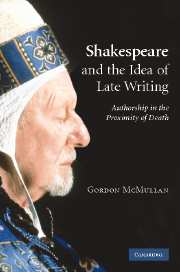Book contents
- Frontmatter
- Contents
- Acknowledgements
- Introduction
- 1 Shakespeare and the idea of late writing: authorship in the proximity of death
- 2 The Shakespearean caesura: genre, chronology, style
- 3 The invention of late Shakespeare: subjectivism and its discontents
- 4 Last words/late plays: the possibility and impossibility of late Shakespeare in early modern culture and theatre
- 5 How old is ‘late’? Late Shakespeare, old age, King Lear
- 6 The Tempest and the uses of late Shakespeare in the theatre: Gielgud, Rylance, Prospero
- Notes
- Index
1 - Shakespeare and the idea of late writing: authorship in the proximity of death
Published online by Cambridge University Press: 22 September 2009
- Frontmatter
- Contents
- Acknowledgements
- Introduction
- 1 Shakespeare and the idea of late writing: authorship in the proximity of death
- 2 The Shakespearean caesura: genre, chronology, style
- 3 The invention of late Shakespeare: subjectivism and its discontents
- 4 Last words/late plays: the possibility and impossibility of late Shakespeare in early modern culture and theatre
- 5 How old is ‘late’? Late Shakespeare, old age, King Lear
- 6 The Tempest and the uses of late Shakespeare in the theatre: Gielgud, Rylance, Prospero
- Notes
- Index
Summary
He saw the distinguished thing coming, faced it, and received it with words worthy of all his dealings with life.
O, but they say the tongues of dying men
Enforce attention, like deep harmony.
LA DERNIÈRE PÉRIODE
The Musée Picasso in Paris, housed within the elegant Hôtel Salé in the Marais, offers visitors a representative, chronologically ordered selection of the artist's works – his personal collection, as it happens, subsequently augmented to fill gaps in the narrative – which charts the linear development of an exemplary creative genius, each room representing the successive ‘periods’ of Picasso's artistic life. These visitors learn, if they did not already know, that Picasso lived a very long time. And if they anticipate a certain decline, weariness or loss of control in his work by the time he reached his ninetieth year, then they find that they have to think again. The wall label in Room 20 – which covers the last eleven years of the artist's life, from 1962 to 1973, a phase described simply as ‘La dernière période’ (‘The last period’) – reads as follows:
The last works painted by Picasso, when he was over ninety years old, reflect an extraordinary renaissance, a renewal of figurative language which appears to be a plea for the rediscovered lyrical power of the painted image. The bright, blazing colours, the vehemence of the paint brush forming figures in frenzied swirls or large daubs with splashes and impasto, reveal the vitality and dynamism of an artist for whom painting was more than ever a living matter. Picasso in his old age gave an accomplished example of a return to the ‘childhood’ of art. […] From the dramatic portrait of the old painter to the one of the young artist, the entire life of Picasso is summarized in a creative apotheosis forecasting the trends of contemporary painting.
- Type
- Chapter
- Information
- Shakespeare and the Idea of Late WritingAuthorship in the Proximity of Death, pp. 24 - 64Publisher: Cambridge University PressPrint publication year: 2007
- 1
- Cited by



